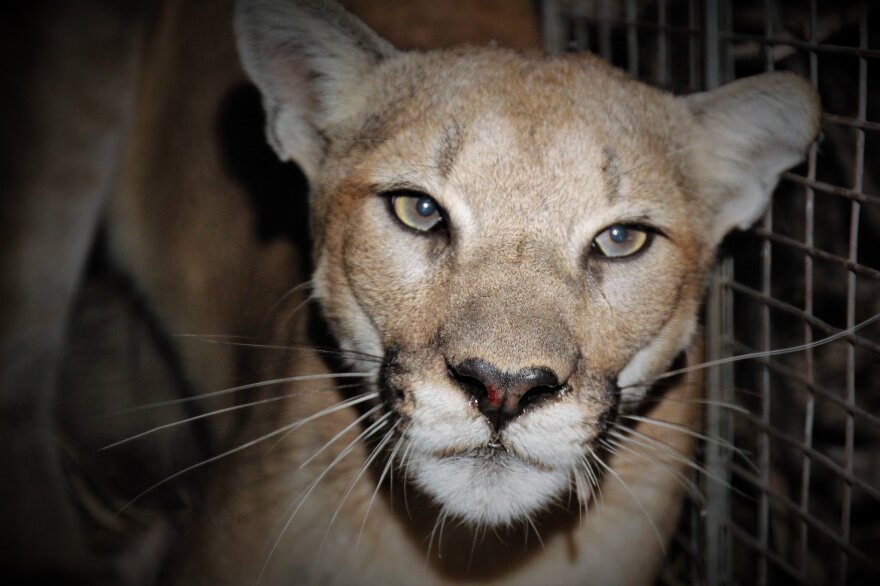With our free press under threat and federal funding for public media gone, your support matters more than ever. Help keep the LAist newsroom strong, become a monthly member or increase your support today .
Meet P-99, LA's New Mountain Lion

A new female mountain lion was found in the western parts of the Santa Monica Mountains.
As the 99th lion to be studied by the Santa Monica Mountains National Recreation Area, she has been named P-99.
She is estimated to be two to three years old and she weighed 75 pounds when she was captured, on Sept. 8.
Per a tweet from the Santa Monica Mountains National Recreation Area, she was found in the Western portion of the Santa Monica Mountains. After she was captured, she was anesthetized for a short period while researchers fitted her with a GPS radio tracking collar and performed an analysis on her.
1/ Our 99th study mountain lion was captured on 9/8/21. P-99 is a female cat estimated to be around 2-3 yo. She was found in the western portion of the #SantaMonicaMountains. While the young mountain lion was anesthetized, a full work-up was performed. pic.twitter.com/WkBfUwZa40
— Santa Monica Mtns (@SantaMonicaMtns) October 17, 2021
The analysis included collecting biological samples, taking morphological measurements, attaching an ear tag and conducting a physical exam. P-99 is one of 13 pumas being tracked in the region.
These big cats are beautiful but they face a host of challenges. Freeways and increasing development have prevented many local mountain lions from moving to new territories and limited their mating options. Sometimes, they get sick from consuming pesticides or eating smaller animals that have consumed pesticides. In other cases, they get hit by cars while trying to cross busy freeways.
Given these obstacles, mountain lions could vanish completely from Santa Monica Mountains in the next 50 years.
Plans are in place to start building a wildlife crossing over the 101 in 2022. This would allow mountain lions (and other animals) to safely traverse the freeway and move to other mountain ranges. When it's done, it will be the world's largest wildlife bridge.
At LAist, we believe in journalism without censorship and the right of a free press to speak truth to those in power. Our hard-hitting watchdog reporting on local government, climate, and the ongoing housing and homelessness crisis is trustworthy, independent and freely accessible to everyone thanks to the support of readers like you.
But the game has changed: Congress voted to eliminate funding for public media across the country. Here at LAist that means a loss of $1.7 million in our budget every year. We want to assure you that despite growing threats to free press and free speech, LAist will remain a voice you know and trust. Speaking frankly, the amount of reader support we receive will help determine how strong of a newsroom we are going forward to cover the important news in our community.
We’re asking you to stand up for independent reporting that will not be silenced. With more individuals like you supporting this public service, we can continue to provide essential coverage for Southern Californians that you can’t find anywhere else. Become a monthly member today to help sustain this mission.
Thank you for your generous support and belief in the value of independent news.

-
The historic properties have been sitting vacant for decades and were put on the market as-is, with prices ranging from $750,000 to $1.75 million.
-
Users of the century old Long Beach wooden boardwalk give these suggestions to safely enjoy it.
-
The Newport Beach City Council approved a new artificial surf park that will replace part of an aging golf course.
-
The utility, whose equipment is believed to have sparked the Eaton Fire, says payouts could come as quickly as four months after people submit a claim. But accepting the money means you'll have to forego any lawsuits.
-
The City Council will vote Tuesday on a proposal to study raising the pay for construction workers on apartments with at least 10 units and up to 85 feet high.
-
The study found recipients spent nearly all the money on basic needs like food and transportation, not drugs or alcohol.







